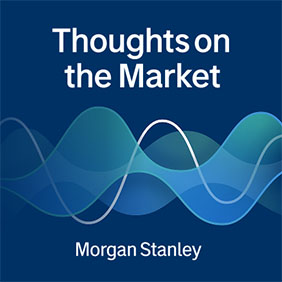A Turnaround in Sight for Healthcare?
October 28, 2025
Our U.S. Biotech and Biopharma analysts Sean Laaman and Terence Flynn discuss the latest developments that could be positioning the healthcare sector for strong outperformance.

Thoughts on the Market
Listen to our financial podcast, featuring perspectives from leaders within Morgan Stanley and their perspectives on the forces shaping markets today.

Up Next
What Happens to Software Developers as AI Can Code?
Transcript
Welcome to Thoughts on the Market. I’m Sanjit Singh, the U.S. Software Analyst at Morgan Stanley.
Today: how AI is transforming software and what that means for developers.
It’s Friday, October 24th, at 10am in New York.
There's been a lot of news stories and anecdotal accounts about AI taking over jobs, especially in the software industry. You may have heard of vibe coding, where people can use natural language prompts, guiding AI to build software applications. So yes, AI is creating a world where software writes itself. But at the same time, the demand for human creativity only grows.
The introduction of AI coding assistants has dramatically expanded what software can do, fueling a surge in both the volume of code and the complexity of projects. But instead of shrinking the developer workforce, AI is actually supporting continued growth in developer headcount, even as productivity soars.
We’re estimating the software development market will grow at a 20 percent compound annual growth rate, reaching $61 billion by 2029. And that’s up from $24 billion in 2024. And in terms of the developer population, [research] firms like IDC expect it to jump from 30 million paid developers in 2024 to 50 million by 2029 – that’s a 10 percent annual growth rate. Even the most conservative estimates, like those from the U.S. Bureau of Labor Statistics, see developer jobs growing roughly 2 percent per year through 2033, outpacing overall employment growth.
So, what does this mean for people behind the code?
AI isn’t replacing developers. It’s redefining them. Routine tasks are increasingly handled by AI agents, and this frees up developers to become curators, reviewers, architects, and most important problem-solvers.
The upshot? Companies may need fewer developers for repetitive work, but the overall demand for skilled engineers remains robust. As AI lowers the barrier to entry, the pool of people who can build software applications expands dramatically. But at the same time, the complexity and ambitions of projects rise, keeping experienced developers in high demand.
No doubt, AI coding tools are delivering real productivity gains. Some teams are reporting nearly doubling their code capacity and cutting pull request times in half after adopting AI assistants. Test coverage has increased sharply, resulting in 20 percent fewer production incidents for some organizations. But there is a catch with all this AI-generated code. It’s creating significant new bottlenecks downstream.
An example of this is code review, which is becoming a major pain point. Many organizations are experiencing pull request fatigue, with developers rubber-stamping changes just to keep up. Some teams now require three reviewers for AI-generated change, compared to just one before. And in terms of automated testing, systems are getting overwhelmed because every change made with AI sets off a complete round of test.
Now we estimate productivity gains from AI in software engineering at about 15–20 percent. But in complex projects, the gains are much lower, as the volume of new code often means more bugs and more rework – and hence more human developers.
So where do we go from here?
In our view, the future isn’t about fully autonomous software development. Instead, large enterprises are likely to favor an integrated approach, where AI agents and human developers work side by side. AI will automate more of the software development lifecycle. And that not only includes coding – which, coding typically accounts for 10-20 percent of the software development effort – but other areas like testing, security, and deployment. But humans will remain in the loop for oversight, design, and decision-making. And as software gets cheaper and faster to build, organizations won’t just do the same work with fewer people – they likely will do more.
In short, the need for skilled developers isn’t going away. But it’s definitely evolving. And in the age of AI, it’s not about man versus machine. It’s about man with machine. And so with more software, we see more developers.
Thanks for listening. If you enjoy the show, please leave us a review wherever you listen and share Thoughts on the Market with a friend or colleague today.

Should AI Spending Worry Investors?
Transcript
Andrew Sheets: Welcome to Thoughts on the Market. I'm Andrew Sheets, Head of Corporate Credit Research at Morgan Stanley.
Today – the debate about whether elevated capital expenditure and AI technology is showing classic warning signs of overbuilding and worries for credit.
It's Thursday, October 23rd at 2pm in London.
Two things are true. AI related investment will be one of the largest investment cycles of this generation. And there is a long history of major investment cycles causing major headaches to the credit market. From the railroads to electrification, to the internet to shale oil, there are a number of instances where heavy investment created credit weakness, even when the underlying technology was highly successful.
So, let's dig into this and why we think this AI CapEx cycle actually has much further to run.
First, Morgan Stanley has done a lot of good collaborative in-depth work on where the AI related spend is coming from and what's still in the pipeline. And importantly, most of the spending that we expect is still well ahead of us. It's only really ramping up starting now.
Next, we think that AI is seen as the most important technology of the next decade by some of the biggest, most profitable companies on the planet. We think this increases their willingness to invest and stick with those investments, even if there's a lot of uncertainty around what the return on all of this expenditure will ultimately be.
Third, unlike some other major recent capital expenditure cycles – be they the internet of the late 1990s or shale oil of the mid 2010s, both of which were challenging for credit – much of the spending that we're seeing today on AI is backed by companies with extremely strong balance sheets and significant additional debt capacity. That just wasn't the case with some of those other prior investment cycles and should help this one run for longer.
And finally, if we think about really what went wrong with some of these prior capital expenditure cycles, it's often really about overcapacity. A new technology – be it the railroads or electricity or the internet – comes along and it is transformational.
And because it's transformational, you build a lot of it. And then sometimes you build too much; you build ahead of the underlying demand. And that can lower returns on that investment and cause losses.
We can understand why large levels of AI capital investment and the history of large investment cycles in the past causes understandable concern. But when tying these dynamics together, it's important to remember why large investment cycles have a checkered history. It's usually not about the technology not working per se, but rather a promising technology being built ahead of demand for it and resulting in excess capacity driving down returns in that investment, and the builders lacking the financial resources to bridge that gap.
So far, that's not what we see. Data centers are still seeing strong underlying demand and are often backed by companies with exceptionally good resources. We need to watch if either of these change.
But for now, we think the AI CapEx cycle has much further to go.
Thank you as always for your time. If you find Thoughts on the Market useful, let us know by leaving a review wherever you listen. And also tell a friend or colleague about us today

Sign up to get Morgan Stanley Ideas delivered to your inbox.
Thank You for Subscribing!
Would you like to help us improve our coverage of topics that might interest you? Tell us about yourself.



